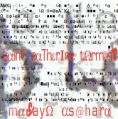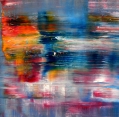AL007 - Masayo Asahara - Saint Agnes Fountain - Download only
TweetListen

It's with great pleasure that Discus and Audiolaceration together bring you this re-issue of a genuine classic album, and a 60 minute heavy trip of the highest order! Shades of LaMonte Young, Soft Machine, Magma, Terry Riley from an album which sounds 30 years ahead of its time.
Original sleevenote - A forgotten drone-prog-jazz classic from the 1970s Japanese underground
St Agnes Fountain was composed while Masayo Asahara was completing her masters degree at the University of Osaka in 1974. Asahara's doctorate concerned the music of the early American minimalists, especially LaMonte Young and Tony Conrad, and her composition reflects her involvement not only in that music, but also with the thriving Osaka free jazz scene from whose ranks this one-off band was put together specifically for this recording. Asahara also cites Faust, Soft Machine, and the Rolling Stones as influencing her work during this period. The rather curious title and artwork come via Asahara's parallel studies of mediaeval European history and pagan imagery in Protestant hymnal writing.
Asahara recalls how the record was made: "Before anything else was done, I made the organ part, which is a single chord sustained for around an hour. But by putting the organ through various filters I was able to change the sound around, very gradually at first and then more and more toward the end. Then I went into the studio with Michio, who sketched out the bass lines and then worked out some rhythm parts with Robun who he know from his trio. Once they'd recorded those we made tape loops of certain sections, then spliced the whole thing together. Finally Denzo and Meiji came in and we overdubbed the horn parts together with me playing alto and Michio overdubbing 5 bass trombones. At the last minute we added a few subliminal sounds which I took from a shortwave receiver. And there it was! I really don't believe there's been anything quite like it either before or since."
St Agnes Fountain was recorded at Asahara's own expense, and subsequent attempts to find a label to make the release proved fruitless, unsurprising given the radical and extended nature of the work and the lack of adventurous labels in Japan during that period.
Finally a few test copies were pressed up for band and friends, and the project was forgotten. Shortly after the recording was completed Asahara came to teach in London. The photo of her at Stonehenge with visiting-on-holiday Foschida was taken around that time.
In the mid 1990's Asahara returned once again from Japan, this time permanently, to teach in the electronic music studio at Sheffield University. Her contact with Sheffield's active music community has at last enabled this long overdue release to be made, and we hope that this will be the first of many CDs to feature this radical and farsighted composer.
Masayo Asahara
Organ, filters, synthesizer, alto sax, shortwaves, composer
Michio Foschida
Bass guitar, composer
Robun Dantomi
Drums
Denzo Sawamatsu
Trumpet
Meiji Benko
Tenor saxophone
Chuji Choshi
Producer
"Glacial blocks of organ droning are melted by the fire of free jazz horn playing and the implacable motorik pulse of prime 70's Krautrock.....juicy, psychotropic workout....visceral, noisy, rigorous, immersive" - Pete Marsh, BBC
"Filtered organ coiled into looping metallic torsion forms the spine. It's thickened with feedback and rock churn to hypnotic effect. A drone-prog-jazz tour de force destined to be hailed as a classic." - WIRE
"Comment vont réagir les auditeurs ? Ceux qui connaissent cette scène underground verseront une larme de nostalgie tout en appréciant un travail remarquable, les nouveaux auditeurs commenceront peut être par rire, puis se rendront compte rapidement qu'une très large partie de la musique qu'ils écoutent en ce moment s'est largement inspirée des ancêtres de la marginalité, comme Masayo Asahara." - Philippe RENAUD, IMPROJAZZ
"This is a challenging and interesting release, one which people who thought they had every early krautrock album ever made may well like to add to their collection." - Mark Jenkins, AMPMUSIC
"If drones are what yank your chain then this is Drone Heaven, and some devotees of Riley will find refuge here too." - FREQ
"How this mad experimental psychedelic orgy managed to drift under the radar of collectors is beyond comprehension. the piece sucks the listener into its world and leaves little chance to get out. Highly recommended to fans of O70s experimental music." - Francois Couture, All-Music Guide
"Comes across with imposing vitality" - Artscene
"A very satisfying trip.....Martin Archer's fantasy has resulted in a quite fantastic musical reality" - Aquarius
"It freaked me completely out! Beautiful, heavy, endless torture" - Osaka Now!
"LaMonte Young or Terry Riley in an unholy collision with Faust and Magma? My God, you must submit to 60 minutes of hell composed by this mad woman! You must allow yourself to be drowned in these relentless waves of pure music violence!!" - Osaka Music Scene
"Saint Agnes Fountain" wurde von der Japanerin Masayo Asahara 1974 komponiert, als Teil ihrer Abschlussarbeit an der Universität Osaka. Ihre Doktorarbeit beschäftigte sich mit dem Amerikanischen Minimalismus, insbesondere mit LaMonte Young und Tony Conrad. Zudem war Asahara in der Free-Jazz-Szeme Osakas aktiv. Als wichtige Einflussgeber für ihre damalige Musik nennt die Japanerin heute zudem Faust, Soft Machine und die Rolling Stones. Der etwas seltsame Titel ihrer Komposition beruht darauf, dass Asahara Anfang der 70er Jahre auch Vorlesungen über die Geschichte des mittelalterlichen Europas und die sakrale Kunst des Mittelalters besucht hatte. Ende 1974 nahm Asahara auf eigene Kosten mit einigen Mitstudenten "Saint Agnes Fountain" auf, das in einer verkürzten Version auch in winziger Auflage in Vinyl gepresst wurde. Ein Label fand Asahara damit allerdings nicht. Erst Ende der 90er Jahre, nachdem Asahara eine feste Anstellung im Electronic Music Studio der Universität Sheffield gefunden hatte, bemühte sie sich wieder um die Veröffentlichung. 2003 war es dann soweit und die originale Version von "Saint Agnes Fountain" erschien in kleiner Auflage auf dem Label Audiolaceration auf CD. Kingt doch interessant, oder? Ist aber alles Blödsinn, auch wenn es so ähnlich auch im Beiheft des wirklich 2003 erschienen "Saint Agnes Fountain" geschrieben steht! Masayo Asahara ist in Wirklichkeit Martin Archer, Multiinstrumentalist, Komponist und Elektroniktüftler aus Sheffield. Die Geschichte um Frau Asahara hat er sich ausgedacht, um unter diesem Pseudonym progressiv-krautig-elektronische Musik zu veröffentlichen, die anders ist, als die, die er sonst produziert. Warum nicht? Zur Musik! Wenig überraschend gibt es auf "Saint Agnes Fountain" ein progressiv-krautig-elektronisches Klanggemenge zu hören, das durchaus von den im ersten Abschnitt genannten Musikern und Bands (ohne die Stones) beeinflusst scheint. Archer und Mitstreiter (die übrigens in Wirklichkeit UTT Foster, Rob Dainton, Derek Saw, Mick Beck und Charlie Collins heißen) erzeugen hier ein freiformatig-rockendes Soundgewebe, bestimmt von allerlei bearbeitetem Instrumentalklang, ausufernder Tastenelektronik, Bass und Schlagzeug. Bisweilen lassen sich darin auch die in der Besetzungsliste genannten Instrumente solistisch ausmachen (Sax, Trompete, Orgel, Posaune). Ab und an kommt es zu voluminösen bzw. wüst-wirren ("Jazzy Feak Out") Ausbrüchen oder bizarren Retroeinlagen (das Orgelsolo in "Third Tempo Plus Organ Solo" könnte direkt von Mike Ratledge stammen). Ansonsten schreitet die Musik sehr dicht, mächtig und repetitiv dahin. Etwas zäh ist der Beginn des Ganzen, tut sich doch in den ersten beiden (sehr langen) Tracks nicht wirklich viel. So richtig los geht es dann mit "First Tempo". Ja also ... wer experimentelle, hypnotisch-machtvolle progressiv-krautig-elektronische Musik schätzt, der sollte dieser Scheibe mal ein Ohr leihen, insbesondere wenn er das Album "Outside the Dream Syndicate" liebt. So ein wenig stecken in "Saint Agnes Fountain" die (oder einige der) Wurzeln des Orchestra of the Upper Atmosphere, auch wenn die Klänge sehr viel minimalistischer aus den Boxen kommen. Achim Brieling, BABYBLAUE SEITEN





 19CD - Masayo Asahara - Saint Catherine Torment - CD plus download
19CD - Masayo Asahara - Saint Catherine Torment - CD plus download 68CD - Meloche / Archer / Robair / Hodnett - The Sincerity Of Light - CD plus download
68CD - Meloche / Archer / Robair / Hodnett - The Sincerity Of Light - CD plus download